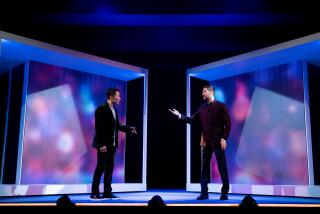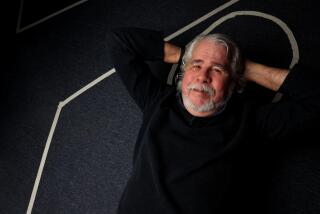Making Science, If Not a Play Itself, Sexy
“Physics is like sex,” Richard Feynman once said, honing both his philosophic worldview and his pickup lines. “Sure, it has some practical results, but that’s not why we do it.”
You don’t hear that one in “QED,” Peter Parnell’s 1 1/2-person play now in its world premiere at the Mark Taper Forum. You hear many others, though. The bongo-slapping, California Institute of Technology-affiliated, Nobel Prize-winning physicist--for much of the 20th century, the world’s ideal of a really fun science guy--died in 1988. Now he has returned for one more office-hours chat, with Alan Alda having a ball as Feynman. Allison Smith takes the 1/2-role, that of Feynman’s wide-eyed, bushy-tailed student, eager for knowledge.
In addition to quod erat demonstrandum (that proves it), QED stands for quantum electrodynamics, a theory (in the words of John and Mary Gribbin, writing in “Richard Feynman: A Life in Science”) describing “all interactions involving light (photons) and charged particles . . . as far as the everyday world is concerned, QED explains everything that isn’t explained by gravity.”
For those who feel they may need a little lie-down after reading that, let alone anything more detailed on the subject, don’t worry. Parnell, a co-producer on TV’s “The West Wing,” last represented at the Taper by his two-part adaptation of “The Cider House Rules,” throws a fair amount of physics at the audience, but in a don’t-worry-be-happy way. It’s not crucial to catch it all. It’s the man behind the theories, and the bongos, that got Alda, Parnell and director Gordon Davidson thinking about Feynman’s stage possibilities.
Those possibilities have emerged only partly realized. After an engaging first act, “QED” loses its way in the second, uncertain in terms of form and focus. Alda’s an enthusiastic presence throughout, and his audience rapport is formidable--as was Feynman’s. But the actor, who initiated this project, can do only so much to suggest what the text avoids--namely, anything messy or controversial, any of Feynman’s true, rich contradictions. Feynman’s many fans will find nothing to offend them here. That’s not necessarily a sign of dramaturgical success.
The play is set in June 1986, in Feynman’s Caltech office. He enters pounding away on his beloved drum, to the tune of “There Is Nothin’ Like a Dame.” Tonight Feynman will portray the chief of Bali Ha’i in the Caltech production of “South Pacific.” Meantime, he has a lecture to write, on the topic of “What We Know.”
He listens to his phone messages, then turns to the audience and tells story after story, many of them funny, some moving. The most affecting material relates to his involvement in the Manhattan Project, coinciding with the death of his first wife, Arline.
Early on, “QED” settles comfortably into the shoes of solo shows like “Tru” (Capote, that is) or “Full Gallop,” the Diana Vreeland tribute. But then we hear the voice of That Second Character, student Miriam Field (Smith) outside Feynman’s door. He agrees to see her in a half-hour. Feynman talks to us some more, before heading off to do his show, and to greet some well-lubricated Russian friends whom Feyman’s pal Ralph Leighton is hosting.
Act 2 makes an attempt at actual two-character-playdom, for the worse. After the post-performance party, the student follows Feynman back to his office, to talk about her future in physics and to let him sketch her portrait. He undergoes a bout of the late-night fantods; she helps him through it.
Alas, this is Parnell’s least convincing material. Though director Davidson guides “QED” with a steady hand, he and choreographer Donald McKayle err in trying to turn the drum-crazy dance into an audience-pleasing climax.
There’s so much raw material here, so many choice anecdotes. Feynman was the one who, with one plop of an O-ring into a glass of ice water, explained NASA’s space shuttle Challenger disaster. The kid from Far Rockaway in Queens, N.Y., the enfant terrible of the Manhattan Project, made physics hot, both as high science and pop art. All that, and Feynman liked to hang out in Gionanni’s, a strip joint not far from his home, the one where he spent his years with his third wife. (His second marriage has been airbrushed out of the play and, oddly, even out of the Taper program’s Feynman timeline.)
Parnell crams in as much as he can. What’s missing from “QED” is the stuff that makes academia such an innately theatrical wellspring--the rivalries, the charges of theory-swiping, the back-stabbing. Parnell (like Alda, to some extent) is eager to make us like his subject, though he has ignored a lot of what makes him provocative. It’s an entertaining introductory course for an act--Alda is very easy company--but I didn’t buy a photon of Act 2.
*
* “QED,” Mark Taper Forum, Music Center of Los Angeles County, 135 N. Grand Ave., downtown. Wednesdays-Fridays, 8 p.m.; Saturdays, 2:30 and 8 p.m.; Sundays, 2:30 p.m. Exceptions: No performance this Saturday at 2:30 p.m.; April 29 performance is at 7:30 p.m., not 2:30 p.m.; additional performance May 8 at 8 p.m. Ends May 13. $30-$44. Public rush $12 two hours before curtain on some performances. (213) 628-2772. Running time: 2 hours.
Alan Alda: Richard Feynman
Allison Smith: Miriam Field
Written by Peter Parnell. Inspired by Richard Feynman and Ralph Leighton’s “Tuva or Bust!”’ Directed by Gordon Davidson. Scenic design by Ralph Funicello. Costumes by Marianna Elliott. Lighting by D Martyn Bookwalter. Sound by Jon Gottlieb. Movement by Donald McKayle. Creative consultant Ralph Leighton. Production stage manager Mary K Klinger.
More to Read
The biggest entertainment stories
Get our big stories about Hollywood, film, television, music, arts, culture and more right in your inbox as soon as they publish.
You may occasionally receive promotional content from the Los Angeles Times.










